Last year I received an enquiry from the Swiss company Caran d’Ache who asked me if I would like to test a few prototypes of their new pastel pencils. As a result of this contact, we established an interesting working relationship which took me to Geneva to the main office and production site with my fellow painter Susanne Mull.
As I already mentioned in my blog entry about pigments, the production of art materials is a very complex process. After having spoken to the employees I realize how much work, enthusiasm and dedication are needed to start a new production line and put it on the market. I really admire the chemists and production workers with their outstanding expertise, wealth of experience and specialist knowledge! And I was also deeply impressed by the seemingly endless amount of experimentation that goes into achieving the precise level of consistency for the pastel pencils.
Although we visited most of the production site, I would like to concentrate on the new pastel pencils which are really interesting.
Due to their molecular structure, pigments have different particle sizes. From the manufacturer’s point of view, this means that you cannot simply choose 70 pigments, mix them together with a binder and put them through the production process. Each pigment reacts in a different way and every pencil has its own specific formula and composition. This has to be found for each individual pastel pencil so that it meets various requirements, such as light-fastness, consistency, range of colour combination, the satisfaction and demands of the user as well as the price, just to name a few. In addition, not every pigment is suitable for the production process because the lead is very sensitive and can easily break. I think, in future, I will probably see the shelves of all manufacturers of artists’ materials in a completely different light.
First of all, the dry pigment mixture is spun in a machine (a bit like a tumble dryer ) until the pigment particles are refined as finely as possible so that the pigment structure is not destroyed.
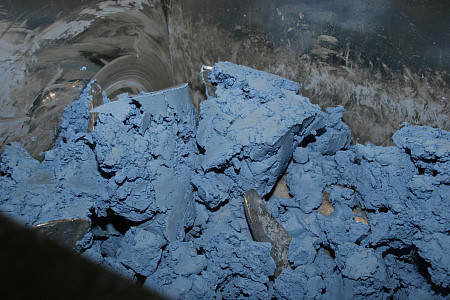
© Astrid Volquardsen, 2011
Binder and distilled water are added and slowly kneaded until it is like dough. The dough is pressed into a cylinder with a capacity of approximately 15 kg and it is then processed during the next stage to make the actual pastel leads.
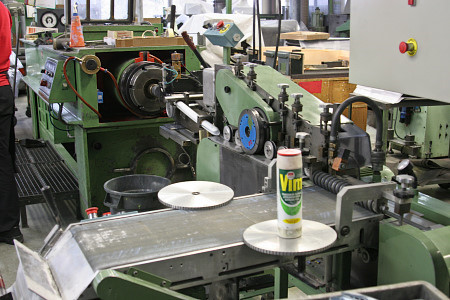
© Astrid Volquardsen, 2011
Unfortunately, the machine was not in operation at the time. Two employees are always necessary to make the pastel pencils because the leads tend to break easily. One person makes sure that the leads are carefully fed through, while the second person places them in a receptacle ready for the next step.
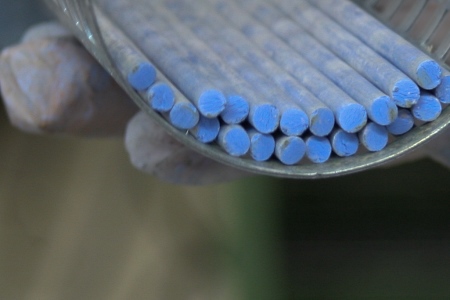
© Astrid Volquardsen, 2011
Since the pastel leads are so sensitive, only a few are stored in the receptacle and placed in a special furnace for hardening. Here, they are heated up only slightly because some pigments tend to »oxidise« at certain temperatures and would therefore undergo a change in appearance. During this process the leads are turned so that they come out straight, round and slightly hardened.
The art of making pastel pencils is to find precisely the right balance of pigment and binder with the aim of using just a sufficient level of binder to achieve the characteristics of a pastel stick but as much as is necessary to prevent the leads from breaking.
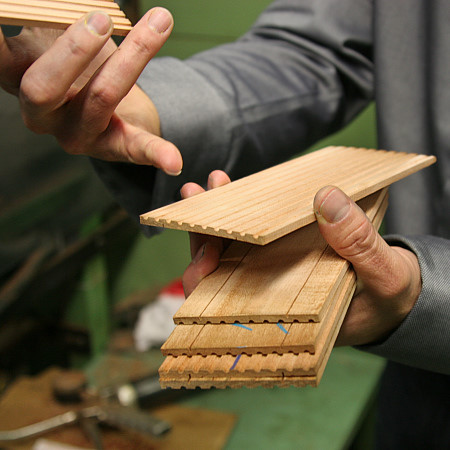
© Astrid Volquardsen, 2011
Throughout the production process particular care is taken that all leads are even and show no signs of damage or cracks. Any damaged pencils are rejected immediately. For the next step it is essential that all leads are homogeneous so that they fit in the grooves of a wooden board. The following steps take place in an automated process: insertion, lining up, affixing another wooden panel and cutting into individual pencils.
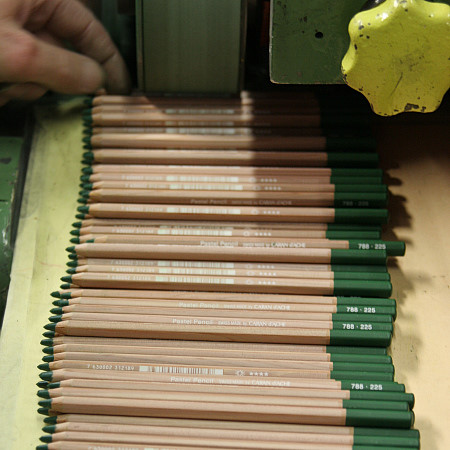
© Astrid Volquardsen, 2011
At first glance, the next step does not look very spectacular: this is when the pastel pencils are sharpened. I was surprised to see how much work went into this stage of the process before it actually takes place. By performing a few clever actions as effectively and as carefully as possible, a sharpening method is found and the machine adjusted accordingly. I was also impressed by the degree of dedication and precision with which the operators worked on the machines.
And, I hasten to add, not just on this one machine! All the machines in this factory are unique and adapted to these special production processes. The staff were extremely friendly and cooperative; they explained the different procedures, willing showed us their work, answered all our questions and were pleased to see our amazement.
Finally, the pencils are dipped in an immersion bath and the coloured markings and number of the colour are added to on the end piece. Up until then I had never considered how much time and effort goes into such a product. The colour of the end piece has to correspond to the actual colour of the pigment. That’s easy, or so we would think. The available pigment mixture has to be combined with the corresponding binder specially for coating varnishes and the chemists are kept busy finding out the right compatibilities which need to match the different chemical components in the varnishes.


Lynne
I am fascinated and will be watching with interest to hear your review on this new range.
Cheers from Hot South Australia
Lynne
fabian lübker
Hallo Astrid,
interessanter Beitrag, wie früher in der Sendung mit der Maus. Eine Frage habe ich noch:
Welche Bindemittel werden denn den Pigmenten zugesetzt? Ich frage deshalb, weil es in der Nähe meiner Arbeitsstätte einen tollen Pigmentladen gibt und es mich immer in den Fingern juckt, aus diesen Pigmenten mal was zu machen, z.B. P´kreiden.
Viele Grüße Fabian
Astrid
Hallo Fabian,
die Bindemittel sind Betriebsgeheimnisse der Firmen! Ich werde einen Beitrag über Bindemittel schreiben, aber das wird noch ein bißchen warten müssen. Ansonsten gibt es bei http://www.kremer-pigmente.de eine Broschüre von Pip Seymore zu bestellen. Dort wird genau beschrieben in welchen Mengen und mit welchen Bindemitteln/Pigmenten man Pastelle selber herstellen kann.
Casey Klahn
Very fascinating. I will link to this and share your report with my readers, too. Very well blogged.
This is a fine line of pencils, and we are lucky to have the product.
Loriann
Great post Astrid! thanks for taking the time to write such a complete report. I learned a lot! Hope all is well.
PS Is Susanne the wonderful Susanne I met in Dakota?
Astrid
Hi Loriann,
how nice to hear from you! Everything is fine overhere and yes, I went with the wonderful Susanne.